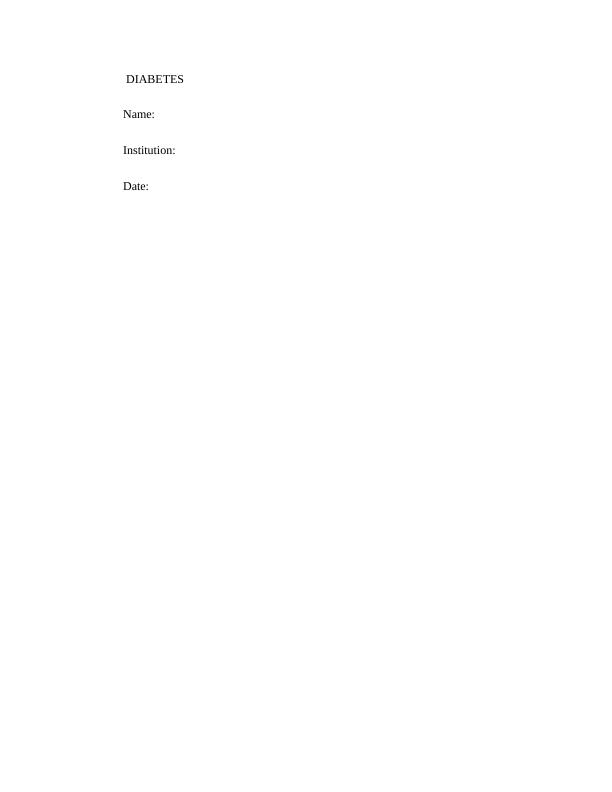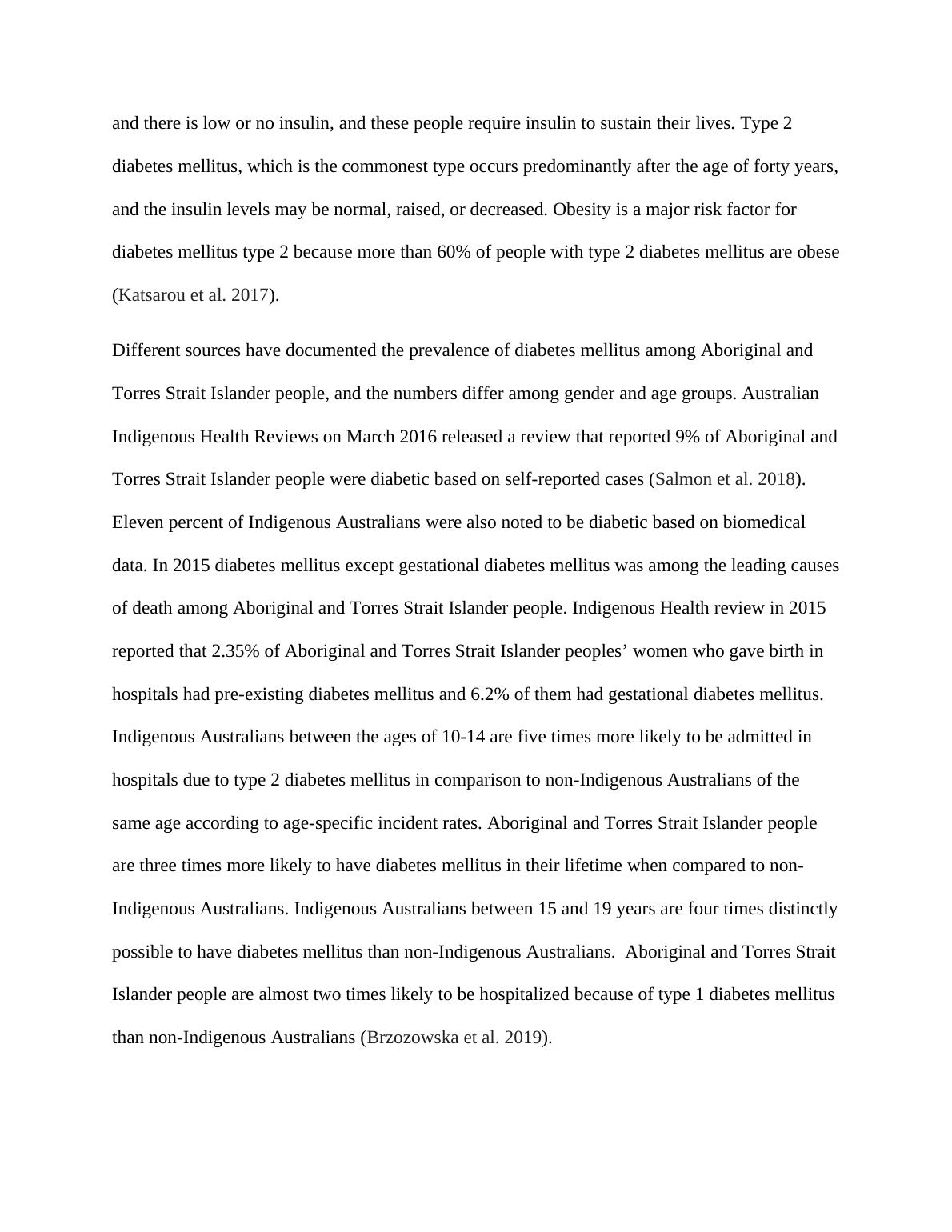Diabetes among Aboriginal and Torres Strait Islander people in Australia
Added on 2022-11-10
8 Pages2145 Words210 Views
DIABETES
Name:
Institution:
Date:
Name:
Institution:
Date:

Aboriginal and Torres Strait Islander people who are also known as Indigenous Australians were
the first people in Australia. They are the original Australians having lived in Australia about 50
thousand to 120 thousand years. Aboriginal and Torres Strait Islander Australians were hunters
and gatherers before the arrival of the whites’ who colonized them. Aboriginal and Torres Strait
Islander suffered a lot under the rule of the white because many laws made during the time
marginalized them. Indigenous Australians suffered many health issues such as diabetes, oral
health, hearing, sight, and other senses. This essay will be discussing diabetes as a health issue
suffered by Aboriginal and Torres Strait Islander people and how the statistics compare with
those of non-Indigenous Australians. History of Indigenous Australians colonization and its
impact on the health issue diabetes will also be discussed. This essay will also look at how
Aboriginal and Torres Strait Islander peoples’ culture has impacted on addressing diabetes.
Diabetes is an endocrine disease that affects how insulin controls blood sugar in the body.
Diabetes occurs when insulin is unable to control glucose, and the levels of blood glucose are
increased above the normal reference ranges resulting in hyperglycemia. The normal reference
range for blood glucose is 4-5.4 mmol/L when fasting and up to 7.8 mmol/L two hours after a
meal (American Diabetes Association. 2017). There are two common types of diabetes mellitus,
namely diabetes mellitus type 1 and diabetes mellitus type 2, which are insulin-dependent and
non-insulin dependent, respectively. Diabetes mellitus has three classic symptoms which patients
present with before a diagnosis is made, and they are polyphagia, polyuria, and polydipsia and
also type 1 has weight loss as a symptom. The other types of diabetes mellitus are gestational
diabetes mellitus that occurs only in some pregnant women but return to normal after the
pregnancy and diabetes mellitus secondary to other causes such as endocrinopathies. Type 1
diabetes mellitus is called juvenile diabetes mellitus because it occurs mostly before 30 years,
the first people in Australia. They are the original Australians having lived in Australia about 50
thousand to 120 thousand years. Aboriginal and Torres Strait Islander Australians were hunters
and gatherers before the arrival of the whites’ who colonized them. Aboriginal and Torres Strait
Islander suffered a lot under the rule of the white because many laws made during the time
marginalized them. Indigenous Australians suffered many health issues such as diabetes, oral
health, hearing, sight, and other senses. This essay will be discussing diabetes as a health issue
suffered by Aboriginal and Torres Strait Islander people and how the statistics compare with
those of non-Indigenous Australians. History of Indigenous Australians colonization and its
impact on the health issue diabetes will also be discussed. This essay will also look at how
Aboriginal and Torres Strait Islander peoples’ culture has impacted on addressing diabetes.
Diabetes is an endocrine disease that affects how insulin controls blood sugar in the body.
Diabetes occurs when insulin is unable to control glucose, and the levels of blood glucose are
increased above the normal reference ranges resulting in hyperglycemia. The normal reference
range for blood glucose is 4-5.4 mmol/L when fasting and up to 7.8 mmol/L two hours after a
meal (American Diabetes Association. 2017). There are two common types of diabetes mellitus,
namely diabetes mellitus type 1 and diabetes mellitus type 2, which are insulin-dependent and
non-insulin dependent, respectively. Diabetes mellitus has three classic symptoms which patients
present with before a diagnosis is made, and they are polyphagia, polyuria, and polydipsia and
also type 1 has weight loss as a symptom. The other types of diabetes mellitus are gestational
diabetes mellitus that occurs only in some pregnant women but return to normal after the
pregnancy and diabetes mellitus secondary to other causes such as endocrinopathies. Type 1
diabetes mellitus is called juvenile diabetes mellitus because it occurs mostly before 30 years,

and there is low or no insulin, and these people require insulin to sustain their lives. Type 2
diabetes mellitus, which is the commonest type occurs predominantly after the age of forty years,
and the insulin levels may be normal, raised, or decreased. Obesity is a major risk factor for
diabetes mellitus type 2 because more than 60% of people with type 2 diabetes mellitus are obese
(Katsarou et al. 2017).
Different sources have documented the prevalence of diabetes mellitus among Aboriginal and
Torres Strait Islander people, and the numbers differ among gender and age groups. Australian
Indigenous Health Reviews on March 2016 released a review that reported 9% of Aboriginal and
Torres Strait Islander people were diabetic based on self-reported cases (Salmon et al. 2018).
Eleven percent of Indigenous Australians were also noted to be diabetic based on biomedical
data. In 2015 diabetes mellitus except gestational diabetes mellitus was among the leading causes
of death among Aboriginal and Torres Strait Islander people. Indigenous Health review in 2015
reported that 2.35% of Aboriginal and Torres Strait Islander peoples’ women who gave birth in
hospitals had pre-existing diabetes mellitus and 6.2% of them had gestational diabetes mellitus.
Indigenous Australians between the ages of 10-14 are five times more likely to be admitted in
hospitals due to type 2 diabetes mellitus in comparison to non-Indigenous Australians of the
same age according to age-specific incident rates. Aboriginal and Torres Strait Islander people
are three times more likely to have diabetes mellitus in their lifetime when compared to non-
Indigenous Australians. Indigenous Australians between 15 and 19 years are four times distinctly
possible to have diabetes mellitus than non-Indigenous Australians. Aboriginal and Torres Strait
Islander people are almost two times likely to be hospitalized because of type 1 diabetes mellitus
than non-Indigenous Australians (Brzozowska et al. 2019).
diabetes mellitus, which is the commonest type occurs predominantly after the age of forty years,
and the insulin levels may be normal, raised, or decreased. Obesity is a major risk factor for
diabetes mellitus type 2 because more than 60% of people with type 2 diabetes mellitus are obese
(Katsarou et al. 2017).
Different sources have documented the prevalence of diabetes mellitus among Aboriginal and
Torres Strait Islander people, and the numbers differ among gender and age groups. Australian
Indigenous Health Reviews on March 2016 released a review that reported 9% of Aboriginal and
Torres Strait Islander people were diabetic based on self-reported cases (Salmon et al. 2018).
Eleven percent of Indigenous Australians were also noted to be diabetic based on biomedical
data. In 2015 diabetes mellitus except gestational diabetes mellitus was among the leading causes
of death among Aboriginal and Torres Strait Islander people. Indigenous Health review in 2015
reported that 2.35% of Aboriginal and Torres Strait Islander peoples’ women who gave birth in
hospitals had pre-existing diabetes mellitus and 6.2% of them had gestational diabetes mellitus.
Indigenous Australians between the ages of 10-14 are five times more likely to be admitted in
hospitals due to type 2 diabetes mellitus in comparison to non-Indigenous Australians of the
same age according to age-specific incident rates. Aboriginal and Torres Strait Islander people
are three times more likely to have diabetes mellitus in their lifetime when compared to non-
Indigenous Australians. Indigenous Australians between 15 and 19 years are four times distinctly
possible to have diabetes mellitus than non-Indigenous Australians. Aboriginal and Torres Strait
Islander people are almost two times likely to be hospitalized because of type 1 diabetes mellitus
than non-Indigenous Australians (Brzozowska et al. 2019).

End of preview
Want to access all the pages? Upload your documents or become a member.
Related Documents
Diabetes in Australia: Impact on Aboriginal and Torres Strait Islander Australianslg...
|8
|2143
|200
The Effects of Diabetes - Essaylg...
|7
|2140
|41
Illustrate Burden Of Diabetes Aboriginallg...
|8
|2043
|41
Diabetes Among Aboriginals and Straight Islander Australianslg...
|8
|2153
|125
NUR344 Community Action Plan Templatelg...
|6
|1031
|19
Master of Public Health Case Study 2022lg...
|8
|1868
|20
